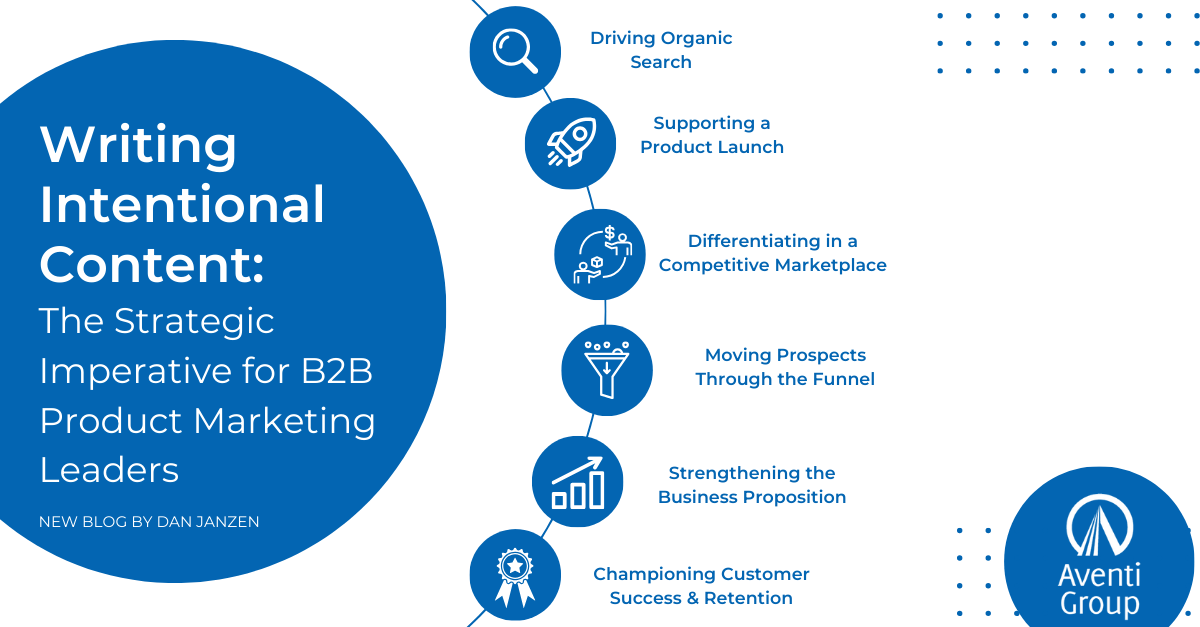Writing Intentional Content: The Strategic Imperative for B2B Product Marketing Leaders
The Power of Purposeful Words: Why B2B Product Marketing Leaders Should Prioritize Intentional Content
As a marketer, you make a point of understanding your customer’s intent. But how well do you understand your own—at least as far as writing is concerned? When you create a piece of collateral, have you thought clearly about the factors driving your choices of form and content?
There are many types of assets in the marketing content catalog: solution briefs, customer stories, white papers, blogs, ebooks, and so on. As you’re designing your content strategy, it can be tempting to fill your shopping basket with a few of each to make sure you’re covered. But marketing success is built on strategy, not spray-and-pray.
To maximize both your marketing efficiency and your market impact, it’s essential to approach your content mix with intentionality: choosing each piece according to the specific outcomes you’re hoping to achieve, from thought leadership to customer retention.
Along the way, let customers tell you whether your content is fulfilling your intention. Monitor your engagement metrics to see not just whether your SEO is bringing people to your content, but how long they’re staying there and whether they’re sharing it. Use these insights to find and address the weak spots in your funnel. Do A/B testing to continually improve and refine the effectiveness of your content.

Driving Organic Search
The purpose of SEO can seem deceptively simple. In a world where most people seek information and find companies via search engines, it’s all about visibility, right? Not so fast. Keep in mind that there can be both good and bad visibility. Once you’ve tapped your knife on your wine glass at the wedding reception, will you have something worthwhile to say?
SEO experts and tools like Google Analytics can help you discover the right keywords to thread through an SEO blog, but how they’re used is up to you. And if the high ranking they earn brings readers to a post that doesn’t deliver real value—if it’s overly basic and generic, annoyingly keyword-stuffed, or a blatant product pitch—it’s a wasted opportunity for your company and your customer alike.
Instead, use SEO as a way to establish thought leadership. People conducting searches for generic keywords are often educating themselves about a product category. By providing a clear vision for the market in concise, user-centric, and thoughtfully written language, you can help the reader advance through their buying journey while positioning your company as a trusted advisor.
As a data-driven form, SEO is a perfect use case for A/B testing. There are many ways to SEO a blog—try a few combinations of keywords and frequencies in your headlines, subheads, and body text to optimize your drawing power.
Keep in mind too that not all platforms are created equal. Beyond freestanding blogs, you can also attract organic traffic via social media. Understanding the nuances of each platform—how a LinkedIn post differs from a tweet or an Instagram story, and the different ways they’re used by people and companies—can help you fine-tune your content strategy.
Supporting a Product Launch
While we’re on the topic of thought leadership—it’s also a key element of any complete launch toolkit. Just-the-facts pieces like press releases, solution briefs, and datasheets serve self-explanatory functions to educate people about exactly what it is you’re launching, but they should be complemented with top-of-the-funnel content presenting the market context in which your product is essential.
While the best blogs focus on a single organizing idea—a new industry trend, an emerging need, an exciting innovation—a longer-form asset like a white paper or ebook allows a more in-depth treatment than the typical blog. You can explain the three factors driving a new set of customer requirements, the four capabilities they need now, the three benefits they’ll see from a new type of solution, and so on (as long as you do it in 2,500 words or preferably less).
On the less reading-intensive side, remember that people love eye candy. Incorporating multimedia elements like videos, infographics, and interactive web experiences will give people more ways to engage with, understand, and remember your message. Try A/B testing a few nurture emails offering different types of assets to see which ones your specific audience and personas like best.
Moving Prospects Through the Funnel
Once your product is on the market, it’s time to escort customers through the stages of consideration, retention, and conversion. The first step is to know who you’re speaking to. Define the personas for your product, use tools like Customer Relationship Management (CRM) and audience analytics to segment your audience accordingly, and create tailored content speaking to the specific pain points and needs of each group.
Once you’ve captured the attention of your prospects, your next challenge is to retain it. That means making it worth their while to continue exploring your content resources. Think about this from their perspective: before they make a buying decision, they want to know more about what your product does, how it can be used, who else has used it, and what experts are saying about it. Mid-funnel content like customer stories, analyst evaluations, and “Top X Ways” pieces are both helpful for the customer and effective for marketers. Solution briefs can highlight all your best points in a tight, user-friendly two-pager.
As customers get closer to a buying decision, pieces keyed to objection-handling can help them overcome any remaining doubts—for example, “X Myths” blogs, video testimonials on ease of implementation or long-term business value, or technical briefs targeting potential IT nay-sayers.
Differentiating in a Competitive Marketplace
Nice marketers finish last. It’s not enough to establish the quality and value of your product—you’ve also got to disqualify the competition from consideration. They’re living in the past, saddling customers with an outdated architecture and day-one tech debt. Their product doesn’t meet modern needs. It’s hard to use, costly to maintain, brittle and inflexible, and feature-poor. The engineers who made it have terrible table manners and they don’t send Mother’s Day cards. (Okay, maybe that’s a bit too far).
The point is, a direct comparison can help customers make their decision based on the most favorable factors for your solution. Whether you choose to call out competitors by name or use a generic but transparent descriptor, a rundown of your most important differentiators and why they’re important offers important reassurance that customers won’t regret their choice.
Differentiation pieces can work as both downloads and blogs, but the latter offers good opportunities for metrics. Are people staying on the page long enough to really absorb your content? That’s a sign you’re giving them good meat for their decision-making process. A glance-and-go audience means you need to dig a little deeper into substance, whether by finding more salient points of comparison or offering more concrete evidence of your advantages.
Strengthening the Business Proposition
Pretty words can go a long way, but as you near the end of the tunnel, it’s time for cold, hard numbers. Before decision-makers will green-light an investment, they want to know it’ll pay off on the bottom line. ROI calculators, infographics, Forrester TEI-style reports, and other data-centric pieces can help your customer build a solid business case, earn buy-in from higher-ups, and get other stakeholders on your side.
Championing Customer Success & Retention
The sale is only the beginning of your journey with the customer—not the end. To strengthen retention, build lifetime customer value, and boost your net promoter score (NPS), you need to make sure customers have the best experience with your company. How-to blogs, updates on new features, podcasts, and webinars can help people get more from their investment while showing your commitment to their success.
Approaching post-sale content on an ad hoc basis—sending occasional emails soliciting ideas from product and support teams, writing a blog on a slow day—makes it much too easy for the well to run dry. Instead, your content strategy for customers should be just as thought-out and structured as it is for prospects, with a cadence of scheduled touches and assets designed to build impact over time.
A/B testing and engagement metrics are as important here as anywhere else. Customer success isn’t just a box to be checked—make sure you’re delivering real value.
Tying It All Together
As you’re curating your marketing mix, remember that diversity applies to the form and function of your content—but not to your brand. Whatever you’re creating, maintaining a consistent voice is just as important as your visual design. A given piece might be a little more formal or conversational than another; you wouldn’t expect an economic analysis to read like a lighthearted exciting-new-feature blog, the same way a sizzle video will have a different feel from a webinar deck. But the underlying personality of your brand should come through in a coherent and familiar way wherever and however people encounter it.
A skilled craftsperson knows her tools intimately, chooses them deliberately for the job at hand, and wields them purposefully. For product marketers, a content toolkit offers endless ways to guide, inform, persuade, and retain. When you use these assets with intent to drive specific outcomes, there’s nothing you can’t build.
Aventi Group can help you take your B2B product marketing content, campaigns, and strategy to new levels of impact. Contact us today to learn how!





